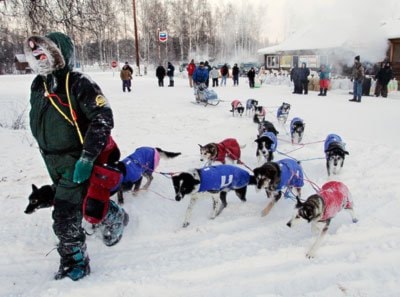EAGLE
Dave Dalton’s dogs live large.
When they aren’t flying around in choppers, or chilling on the Norris glacier with zinc on their noses, they spend afternoons swimming in the local lake.
But apparently, his dogs aren’t fond of splashing around.
“They hate it,” said Dalton.
In September, the Healey musher decided to try training his team in the water.
He built a raft with spaces to attach dogs between the barrels, got a bunch of neoprene life vests, hooked his dogs to the barge, and they started swimming. Dalton pushed the raft around the lake in circles with a skiff.
“We started off with short swims and worked our way up to 45 minutes,” he said.
Every minute the dogs swim equals about 1.6 kilometres of running.
“And it’s great because they don’t overheat.”
In September, before he started swimming his team, Dalton could only train on a four-wheeler for about 6.4 kilometres before the dogs got too hot.
And because it’s the end of the summer the water isn’t too cold, he added.
At first, the dogs tried to scramble up on the barrels to get out of the lake, but the plastic was too slippery.
Eventually they got used to it.
Once the weather cooled down, Dalton started training on his four-wheeler again, and noticed a dramatic difference in his dogs.
“In the past, when we’d get to a hill they would walk up, but this year they were charging the hills,” he said.
Sitting in the Eagle checkpoint in his long johns enjoying a breakfast burrito, Dalton was smiling, even after being tossed around in the jumble ice.
“It seems as though the dogs aren’t as stiff after the runs this year,” he said.
And Dalton attributes it to the swimming.
He’s also giving his team Glycocharge, a type of sugar that penetrates the muscles to help alleviate stiffness every time they stop.
It’s Dalton’s 18th Quest.
And he plans to keep on running the race, as long as he stays in the money.
“It’s still fun being out there,” he said.
Dalton runs dogs all year round, racing in the winter and running heli-mushing trips on the glacier near Juneau during the summer months.
The dogs travel 1,600 kilometres to get there, take a four-hour ferry ride and then fly by helicopter up to the ice fields.
“It’s great; it keeps them in shape and there’s no bugs or mosquitoes up there,” said Dalton. “And dealing with tourists all summer makes the dogs bombproof at checkpoints.” They get used to people and aren’t so skittish.
They also get tough feet running on the ice, he said.
The only trouble is the sun.
It reflects off the ice and burns the dogs’ bellies, noses and ears, causing blisters.
Dalton covers as much bare skin as possible with zinc, but it still gets burnt, he said.
And the glare can cause cataracts in their eyes.
Before he started running dogs fulltime, Dalton drove cab for years.
That’s how he met the manager of his main, and somewhat unusual sponsor — a strip club called Reflections.
“Connie drove cab with me in the ‘80s before she took a job as accountant (at Reflections),” he said. When the owner died, leaving a young daughter behind, Connie helped raise her, started managing the club and became one of Dalton’s sponsors.
“It’s hard getting sponsors for the Quest,” he said. “It’s mostly a local race, and it’s not as well known as the Iditarod.”
Dalton’s only ran the Iditarod once, in ’95. He prefers the Quest “because you usually get a paycheque at the end,” he said.
And by now, he knows every centimetre of trail.
“I run cabin to cabin,” he said.
“I like being happy and warm. And some of my veteran (dogs) know the routine. They start getting real unhappy if I pass a cabin — “No, we’re not going by” —and if I do, they start reserving their energy.”
By Eagle, Dalton was already planning for next year’s Quest.
“There are some things I’d do differently,” he said. Every year there are little things that change. He tried out an IPod this year, but dumped it by the time he’d reached the Central checkpoint, 272 kilometres into the race.
“It’s just another thing to deal with,” he said. “You’re trying to talk to the dogs and you’ve got music blaring and you’re trying to turn it off.” Dalton was wearing two watches, another part of his ever-improving race strategy.
“One year one broke, one year the batteries died, and one year I lost it,” he said, explaining the two timepieces.
It’s the little things that make it easier and speed things up.
He also always wears his headlamp, even in broad daylight.
“That way if you need it you can just push a button,” he said.
Through the jumble ice, and heading to Dawson, Dalton was hopeful and in the race.
“I’m still within striking distance,” he said.
“Anything can happen in a 1,000-mile dog race.”
